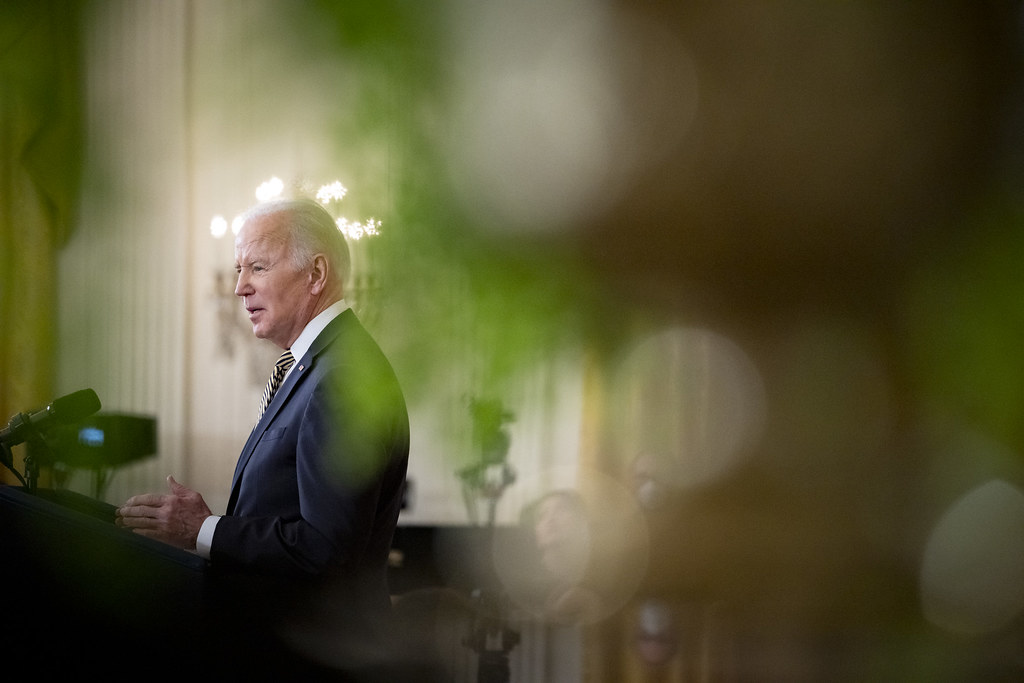After a four-year delay, the Violence Against Women Act, President Joe Biden’s signature legislative accomplishment as senator, was reauthorized for the fourth time in March. The law was initially enacted in 1994 with strong bipartisan support, but subsequent reauthorizations have been more fiercely contested. Republicans have opposed efforts to expand VAWA’s protections to LGBTQ+ communities, regulate firearm possession by people who committed acts of gender-based violence, empower tribal courts to hear cases involving gender-based violence against Native people committed by non-Natives, and extend immigration protections to undocumented survivors of violence. The 2022 reauthorization ultimately passed by healthy majorities both in the House of Representatives and in the Senate. Biden held a celebration in the East Room.
The new version, as the White House noted, makes a number of important improvements to the existing law. It increases support for people from underserved communities, for culturally specific services, and for services in rural communities. It funds restorative justice programs (in limited circumstances). It increases allocations for prevention programs. It provides legal assistance to prevent evictions, money for transitional housing, and support services for employment for survivors. All of these are things that survivors badly need.
But what VAWA primarily does is promote and fund the criminal legal system. The 2022 reauthorization continues that trend. The law authorizes funding to prosecute cybercrimes. It funds additional training — in this iteration, trauma-informed, victim-centered training — for law enforcement. It underwrites training for forensic nurse examiners, who are often called as witnesses in rape prosecutions. It contains money to prosecute firearms offenses. It promises money to states that enact laws prohibiting law enforcement from having sexual relations with people in their custody and that forbid the use of consent as a defense to those encounters. It funds a pilot project enabling women incarcerated in federal prisons — many of whom are survivors of gender-based violence — to reside (for a short period of time) with children born while they are imprisoned.
What the Violence Against Women Act primarily does is promote and fund the criminal legal system.
That the 2022 version of VAWA is primarily focused on the criminal legal response to gender-based violence will not surprise anyone familiar with its previous incarnations. Enacted as part of the Violence Crime Control and Law Enforcement Act of 1994, after then-Senator Biden asked for “something on women for the crime bill,” VAWA was originally designed to beef up the criminal legal system’s response to intimate partner violence, rape, and sexual assault — and since, the law has never strayed far from that original course. Over the past 28 years, VAWA has poured billions of dollars into the law enforcement response to gender-based violence, a term of art that now includes dating violence, stalking, sex trafficking, and cybercrimes. By 2013, approximately 85% of VAWA funding was funneled into the criminal legal system — everything from police and prosecutors to courts and community-based organizations supporting law enforcement’s work.
In fiscal year 2021, Congress appropriated $268 million to VAWA’s two largest grant programs, STOP (Services, Training, Officers and Prosecutors) and Improving Criminal Justice Responses to Sexual Assault, Domestic Violence, Dating Violence, and Stalking, both of which are heavily focused on the criminal legal system. Additional monies flow to law enforcement through a variety of smaller grant programs. Although VAWA has expanded to include other interventions and programs, at its heart, VAWA has always been dedicated to criminalization.
The original VAWA was championed by anti-violence advocates who believed that gender-based violence should be treated as a crime like any other crime. Prior to VAWA’s adoption, advocates pushed for more robust involvement by police and prosecutors in gender violence cases. Through class action lawsuits challenging police and prosecutorial inaction and the promotion of policies like mandatory arrest (requiring police to make arrests in domestic violence cases whenever they had probable cause to do so) and no-drop prosecution (requiring prosecutors to pursue cases regardless of the victim’s desire for that prosecution), anti-violence advocates ensured that law enforcement no longer had the discretion they had previously deployed to avoid intervention.
As a conceptual matter, then, VAWA’s continued reliance on the criminal legal system to address gender-based violence is entirely consistent with the early advocacy of anti-violence feminists. With VAWA, these “carceral feminists” (a term coined by sociologist Elizabeth Bernstein) doubled down on their “vision of social justice as criminal justice, and of punitive systems of control as the best motivational deterrents for men’s bad behavior.” Despite warnings from advocates of color, particularly Black women, that criminalization would fail to meet their justice goals and would be destructive to their communities, carceral feminists joined with law-and-order conservatives to forge the alliance that initially led to VAWA’s passage. And despite growing uneasiness in the anti-violence community about the impact of criminalization on communities of color, VAWA continues to shunt hundreds of millions of dollars each year into the criminal legal system.

As a policy matter, supporting criminalization might make sense if there was reason to believe that criminalization was decreasing or deterring the perpetration of gender-based violence. But no such justification exists. No study conclusively finds a causal link between the passage of VAWA and decreased gender violence in the United States. Although President Biden frequently points to the substantial drop in rates of domestic violence since VAWA was enacted, he just as frequently fails to note that all violent crime in the United States has decreased since VAWA’s passage — by about the same amount. Rates of rape and sexual assault actually decreased less than the drop in the overall crime rate, despite the dedication of hundreds of millions of dollars to the law enforcement response to that violence.
The evidence on whether arrest, prosecution, or incarceration deters recidivist violence is inconclusive. Although early research on arrest in cases of intimate partner violence seemed to suggest that arrest prevented recidivist violence, later replication studies varied: Some found a deterrent effect, some found no effect, and others found that arrest exacerbated violence. No study has found that prosecution or incarceration alone deter intimate partner violence.
This body of evidence makes it clear that criminalization is not “working” — if what we mean by working is that criminalization decreases or deters intimate partner violence. What is plain from these studies is the futility of asking the carceral system to prevent violence. Some of these studies were available at the time of VAWA’s passage in 1994; many more have been conducted in the years since. Yet VAWA continues to turn to the carceral system, a prime example of what law professor Jonathan Simon has called “governing through crime” — addressing social problems through the criminal legal system despite criminalization’s lack of effectiveness.
This body of evidence makes it clear that criminalization is not ‘working’ — if what we mean by working is that criminalization decreases or deters intimate partner violence.
What research has found is that survivors of gender-based violence are not satisfied with the carceral response. Although VAWA has been funding police training on gender-based violence for almost 30 years, a 2015 survey by the National Domestic Violence Hotline found that many people did not call the police for assistance with gender-based violence because they were concerned about how police would respond. More than 80% of people who had not previously contacted police reported feeling afraid to call them again in the future. Almost a quarter of those who called police reported having been arrested or threatened with arrest when they reported gender-based violence. Two-thirds of respondents expressed fear or concern about calling police in the future; 24% said they would not call police again. A soon-to-be-released update of the Hotline survey reveals that mistrust and fear of police have only grown over time, likely exacerbated by the depressingly common reports of police misuse of force generally and of gender-based violence committed by law enforcement specifically.
Prioritizing criminalization as the primary policy response to gender-based violence has had devastating consequences — consequences that can no longer be called unintended because by now we are so familiar with them.
Prioritizing criminalization as the primary policy response to gender-based violence has had devastating consequences — consequences that can no longer be called unintended because by now we are so familiar with them.
Criminalization disproportionately targets people of color, their families, and their communities. Criminalization is tied to higher arrest rates for women. After the adoption of mandatory arrest policies, arrest rates for women, especially Black women, increased substantially — not because women had become more violent, but because of how police implemented those policies. Criminalization makes it more difficult for people to find and keep employment, which is especially problematic given that male under- and unemployment are highly correlated with perpetration of violence. Criminalization deprives communities of long-term residents who can contribute to community stability through parenting, employment, and civic involvement. Criminalization, particularly incarceration, inflicts trauma — and experiencing trauma is correlated with the perpetration of violence. The very policy that VAWA endorses as the optimal way to address gender-based violence exacerbates the correlates of that violence instead. And criminalization of gender-based violence is part of the larger movement in the United States of sending resources into the criminal legal system instead of to the people and communities that so desperately need them. The very failure to provide for people’s real needs, in other words, has created the social conditions for the rise of mass criminalization and incarceration.
It doesn’t have to be this way.
Imagine instead a non-carceral VAWA. A VAWA that targets the correlates of intimate partner violence, like economic insecurity, community instability, and trauma. A VAWA that invests in prevention rather than ineffective after-the-fact interventions. A VAWA that envisions a world where people are not caged and supports communities in their efforts to hold people accountable without inflicting harm.
VAWA could provide direct economic support to survivors of violence. Following the lead of FreeFrom, an organization dedicated to reframing intimate partner violence “as a structural economic issue,” VAWA could provide survivors with unrestricted cash grants that would enable them to meet their immediate economic needs and alleviate the economic dependence that keeps some survivors entrapped in violent relationships. VAWA could provide economic assistance and voluntary employment support and training to those who use violence. Decreasing economic stress can lower rates of violence, a lesson learned during the COVID-19 pandemic. Rates of intimate partner violence increased significantly in the early months of COVID, but dropped in April 2020 — after the first COVID stimulus checks were sent out.
VAWA could redirect the money it sends to the criminal legal system into expanding the pool of affordable housing — regularly cited as survivors’ greatest unmet need — and refurbishing the built environments of distressed communities. VAWA could increase funding for prevention (especially for work with adolescents) and support intervention programs that acknowledge the role that instability and trauma play in the perpetration of violence. VAWA could pilot non-carceral first responder projects, pairing community de-escalation and violence intervention programs with specialists in gender-based violence. VAWA could promote and fund transformative interventions focused on community accountability and healing.
VAWA has been described as a “cornerstone” of President Biden’s public service work. Biden seems to have never doubted the value of criminalizing gender-based violence; indeed, he appears to see it as a moral imperative. But criminalization is a deeply destructive and ultimately ineffective response to gender-based violence. Continuing to tout it as the solution to gender-based violence does a grave disservice to survivors of violence, who are encouraged and expected to rely on a system that may provide temporary assistance but that may also increase trauma and will never uproot the structural and individual harms that underlie violence. To end gender-based violence, we need non-carceral solutions. The VAWA of the future could chart that path.
Header Image: C-SPAN

